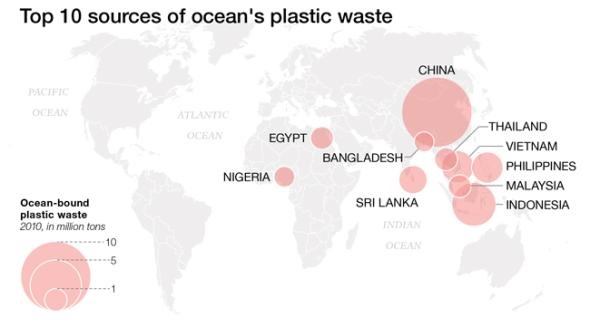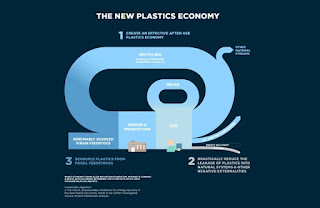Reconsidering Plastics……..
By Prof. Anju Kumar
ISME
Introduction: There is a huge wave of urbanization, affecting the whole world. Urbanization as we know is linked to modernization, industrialization and rationalization. Urban development is a logical coherent system constituting social, economic, cultural and physical development of cities. As a consequence of urbanization, global population has increased tremendously resulting in a huge demand for food and other essentials. This results in an increase in waste generation. One of the main components of the waste that is generated is plastic. A lot has been said about plastics and its detrimental effect on the environment. Imposing a blanket ban on plastics may not be the answer to the plastics challenge.
Plastics today are, omnipresent. Be it in packaging, construction, transportation, healthcare or electronics. They are a combination of low cost, versatility, durability and high strength to- weight ratio material. Plastic is a material which is used extensively in the modern world. It is a functional material offered at a low cost. Plastics are being used twenty fold and their utility is expected to double in the next twenty years. Today nearly everyone, everywhere, every day comes into contact with plastics especially plastic packaging.
Objective: The objective of this article is to understand the New Plastics Economy and how to coexist with this indispensible material.
Methodology: This article is a summary discussion on the Mckinsey report which was brought out along with the Ellen Macarthur foundation at the World Economic Summit at Davos in Jan 2016.
Summary Discussion: There are advantages with plastic packaging. Its barrier properties keep food fresher longer and its low weight offers lighter transportation costs. As a result, plastics are being used extensively as packaging material. Between 2000 and 2015, the share of plastic packaging as a share of global packaging volumes has increased from 17% to 25%. The global plastic packaging market is growing at a rate of 5% annually. In 2013, the industry put 78 million tons of plastic packaging on the market, with a total value of USD 260 billion.
After a short first-use cycle, 95% of plastic packaging material value, or USD 80–120 billion annually, is lost to the economy. A staggering 32% of plastic packaging escapes collection systems, producing substantial economic costs by reducing the productivity of vital natural systems such as the ocean and clogging urban infrastructure. Plastic is a convenience and cheap material which is consumed extensively by human beings.
Plastic in the ocean is a result of people discarding and dumping it after use into the ocean. For the marine eco system, plastics which are not biodegradable are a highly polluting material which is a serious threat to the health of the oceans. Plastic is light in weight and floats and moves around the oceans on account of the currents in the ocean. Plastics affect the marine life as living organisms especially the marine mammals, get caught in the plastic nets and other materials and are unable to come up for air therefore causing havoc to marine life. Therefore the food chain in the marine ecosystem is affected.
The map below is indicative of the fact that China and other South East Asian countries cause marine pollution to a large extent.
The rankings in this chart reflect the largest total amounts of plastic waste flowing into the oceans annually, not the highest per capita amounts. For example, Bangladesh ranks 10th overall, with 867,879 tons, but 187th per capita, at 346 pounds per person. Denmark ranks 143rd overall with 1,974 tons, but 19th per capita, at 1,883 pounds per person.
NG STAFF; J. L. WANG. SOURCE: SCIENCE
The New Plastics Economyoffers a vision and a novel way of thinking about plastics as an effective global material flow, aligned with the principles of the circular economy. The circular economy is a generic term for an industrial economy that is producing no waste and pollution, by design or intention, and in which material flows are of two types, biological nutrients, designed to reenter the biosphere safely, and technical nutrients, which are designed to circulate at high quality in the production system without entering the biosphere as well as being restorative and regenerative by design(Source- Wikipedia)
In the current model, 90% of the plastic packaging generated is either wasted (40% landfilled; 14% incinerated; 4% process losses from recycling) or littered/leaked to the environment (32%), leaving a paltry 10% that is ultimately recycled.
There are three main ambitions captured in the New Plastics Economy.
1. Create an effective after-use plastics economy
Adopt reusable packaging. Increase the rate and awareness of recycling. Using compostable plastic packaging can help to return nutrients of the packaged content to the soil.
2. Drastically reduce the leakage of plastics into natural systems and other negative externalities
Educating after-use collection and infrastructure and directing innovation investment towards creating materials and formats that reduce the negative environmental impact of plastic packaging leakage.
3. Decouple plastics from fossil feedstock
This could happen through the development of materials from renewable sources.
There is a hidden opportunity here which can be used to overcome the drawbacks of a plastic economy. The plastic innovation engine can be used to take the industry into a positive value area with stronger economics and better environmental economics. So, what is the plastic innovation engine? Plastics never become waste, the goal is to reduce the leakage of plastics into the oceans or natural systems, and the environment and ensure it is recycled to the maximum extent.
The raw materials used in plastic production are, cellulose, coal, natural gas, salt and crude oil (fraction called as naptha). This is known as fossil fuel based plastic. This non-biodegradable plastic material takes 400-1000 years to decompose. To sustain the ever depleting fossil fuels, GHG (Green house gas) based plastic is thought of as an innovation in plastic manufacturing. With a successful pilot test, this material is awaiting manufacture on a larger scale. This also contributes to capturing the methane that is released during the degrading process of plastics. Instead of looking at carbon emission as an environmental problem, it is used as raw material to create material. The production commences with capturing methane emitted at landfills, farms, and the methane thus captured is used as a raw material in the plastic manufacturing process. This is known as GHG based plastic, which can replace the non-biodegradable plastic.
Conclusion: A collaborative approach between all stakeholders across the plastic value chain is required and this should be a systemic change. The report proposes the creation of an independent coordinating vehicle to set direction, establish common standards and systems, overcome fragmentation, and foster innovation opportunities.
References
World Economic Forum, Ellen MacArthur Foundation and McKinsey & Company,
The New Plastics Economy – Rethinking the future of plastics
Weforum.org




